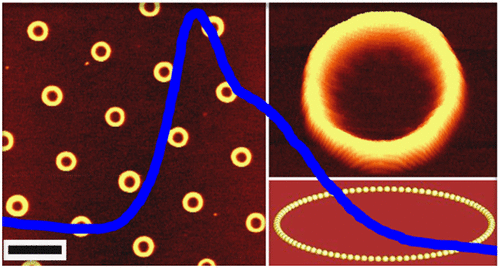当前位置:
X-MOL 学术
›
J. Phys. Chem. B
›
论文详情
Our official English website, www.x-mol.net, welcomes your feedback! (Note: you will need to create a separate account there.)
Using Particle Lithography to Tailor the Architecture of Au Nanoparticle Plasmonic Nanoring Arrays
The Journal of Physical Chemistry B ( IF 3.3 ) Pub Date : 2017-09-25 00:00:00 , DOI: 10.1021/acs.jpcb.7b06357 Arika Pravitasari 1 , Maelani Negrito 1 , Kristin Light 1 , Wei-Shun Chang 2 , Stephan Link 2, 3 , Matthew Sheldon 1, 4 , James D. Batteas 1, 4
The Journal of Physical Chemistry B ( IF 3.3 ) Pub Date : 2017-09-25 00:00:00 , DOI: 10.1021/acs.jpcb.7b06357 Arika Pravitasari 1 , Maelani Negrito 1 , Kristin Light 1 , Wei-Shun Chang 2 , Stephan Link 2, 3 , Matthew Sheldon 1, 4 , James D. Batteas 1, 4
Affiliation

|
The facile assembly of metal nanostructured arrays is a fundamental step in the design of plasmon enhanced chemical sensing and solar cell architectures. Here we have investigated methods of creating controlled formations of two-dimensional periodic arrays comprised of 20 nm Au nanoparticles (NPs) on a hydrophilic polymer surface using particle lithography. To direct the assembly process, capillary force and NP concentration both play critical roles on the resulting nanostructured arrays. As such, tuning these experimental parameters can directly be used to modify the nature of the nanostructures formed. To explore this, two different concentrations of Au NP solutions (∼7 × 1011 or 4 × 1012 NPs/mL) were used in conjunction with a fixed concentration of polystyrene microspheres (PS MS, ∼6 × 109 PS MS/mL). Assembly at a relative humidity (RH) of 45% with the higher concentration resulted in the formation of well-defined Au nanorings of ca. 23 nm in height and 881 nm in diameter with a pitch of 2.5 μm. Assembly at 65% RH with the lower concentration of NPs resulted in Au nanodonut arrays comprised of isolated single Au NPs. To explore the extent of coupling in the well-defined structures, dark field scattering spectra were collected and showed a broad localized surface plasmon resonance (LSPR) peak with a shoulder, which full-wave electrodynamics modeling (finite-difference time domain (FDTD) method) attributed to be a result of pronounced particle–particle coupling along the circumference of the nanoring array.
中文翻译:

使用粒子光刻来调整金纳米粒子等离子纳米环阵列的体系结构
金属纳米结构阵列的便捷组装是等离激元增强化学传感和太阳能电池体系结构设计的基本步骤。在这里,我们研究了使用粒子光刻技术在亲水聚合物表面上形成由20 nm Au纳米粒子(NPs)组成的二维周期阵列受控形成的方法。为了指导组装过程,毛细作用力和NP浓度在最终的纳米结构阵列中都起着至关重要的作用。这样,调整这些实验参数可以直接用于修改所形成的纳米结构的性质。为了探索这一点,使用了两种不同浓度的Au NP溶液(〜7×10 11或4×10 12NPs / mL)与固定浓度的聚苯乙烯微球(PS MS,约6×10 9PS MS / mL)。在相对湿度(RH)为45%且浓度较高的条件下组装时,形成了约200个定义明确的Au纳米环。高度为23 nm,直径为881 nm,间距为2.5μm。在65%相对湿度下以较低的NP浓度进行组装后,产生了由分离的单个Au NP组成的Au纳米甜甜圈阵列。为了探索结构明确的耦合程度,收集了暗场散射光谱,并显示了一个宽的带有肩部的局部表面等离振子共振(LSPR)峰,该峰经过全波电动力学建模(时差有限时域(FDTD))方法)归因于沿纳米环阵列圆周明显的粒子间耦合。
更新日期:2017-09-26
中文翻译:

使用粒子光刻来调整金纳米粒子等离子纳米环阵列的体系结构
金属纳米结构阵列的便捷组装是等离激元增强化学传感和太阳能电池体系结构设计的基本步骤。在这里,我们研究了使用粒子光刻技术在亲水聚合物表面上形成由20 nm Au纳米粒子(NPs)组成的二维周期阵列受控形成的方法。为了指导组装过程,毛细作用力和NP浓度在最终的纳米结构阵列中都起着至关重要的作用。这样,调整这些实验参数可以直接用于修改所形成的纳米结构的性质。为了探索这一点,使用了两种不同浓度的Au NP溶液(〜7×10 11或4×10 12NPs / mL)与固定浓度的聚苯乙烯微球(PS MS,约6×10 9PS MS / mL)。在相对湿度(RH)为45%且浓度较高的条件下组装时,形成了约200个定义明确的Au纳米环。高度为23 nm,直径为881 nm,间距为2.5μm。在65%相对湿度下以较低的NP浓度进行组装后,产生了由分离的单个Au NP组成的Au纳米甜甜圈阵列。为了探索结构明确的耦合程度,收集了暗场散射光谱,并显示了一个宽的带有肩部的局部表面等离振子共振(LSPR)峰,该峰经过全波电动力学建模(时差有限时域(FDTD))方法)归因于沿纳米环阵列圆周明显的粒子间耦合。



























 京公网安备 11010802027423号
京公网安备 11010802027423号